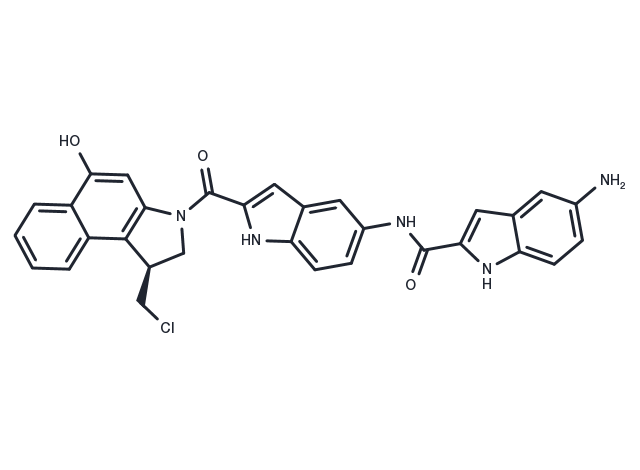Powder: -20°C for 3 years | In solvent: -80°C for 1 year


The cytotoxicity of DC0-NH2 is 1000 times that of commonly used anti-cancer drugs (such as doxorubicin). It is the effect part of ADC. It is a simplified simulation of DC1 and has better stability. DC0-NH2 can bind to the small groove of DNA, and then adenine residue is alkylated by its propabenzindole (CBI) component.

| Pack Size | Availability | Price/USD | Quantity |
|---|---|---|---|
| 25 mg | 6-8 weeks | $ 1,520.00 | |
| 50 mg | 6-8 weeks | $ 1,980.00 | |
| 100 mg | 6-8 weeks | $ 2,500.00 |
| Description | The cytotoxicity of DC0-NH2 is 1000 times that of commonly used anti-cancer drugs (such as doxorubicin). It is the effect part of ADC. It is a simplified simulation of DC1 and has better stability. DC0-NH2 can bind to the small groove of DNA, and then adenine residue is alkylated by its propabenzindole (CBI) component. |
| In vitro | DC0-NH2 (0-3 nM; 72 hours), in the vitality test of breast cancer cell lines, has a high anti-proliferative effect on Ramos, Namalwa and HL60 / s cells, inhibits the proliferation of Namalwa and HL60 / s cells The IC50 values were 7 pM and 5 pM, respectively, and the inhibition range of COLO205 cells was within 100 pM. |
| Molecular Weight | 550.01 |
| Formula | C31H24ClN5O3 |
| CAS No. | 615538-51-7 |
Powder: -20°C for 3 years | In solvent: -80°C for 1 year
You can also refer to dose conversion for different animals. More
bottom
Please see Inhibitor Handling Instructions for more frequently ask questions. Topics include: how to prepare stock solutions, how to store products, and cautions on cell-based assays & animal experiments, etc.
DC0-NH2 615538-51-7 Others DC-0-NH2 DC0NH2 DC0 NH2 inhibitor inhibit
